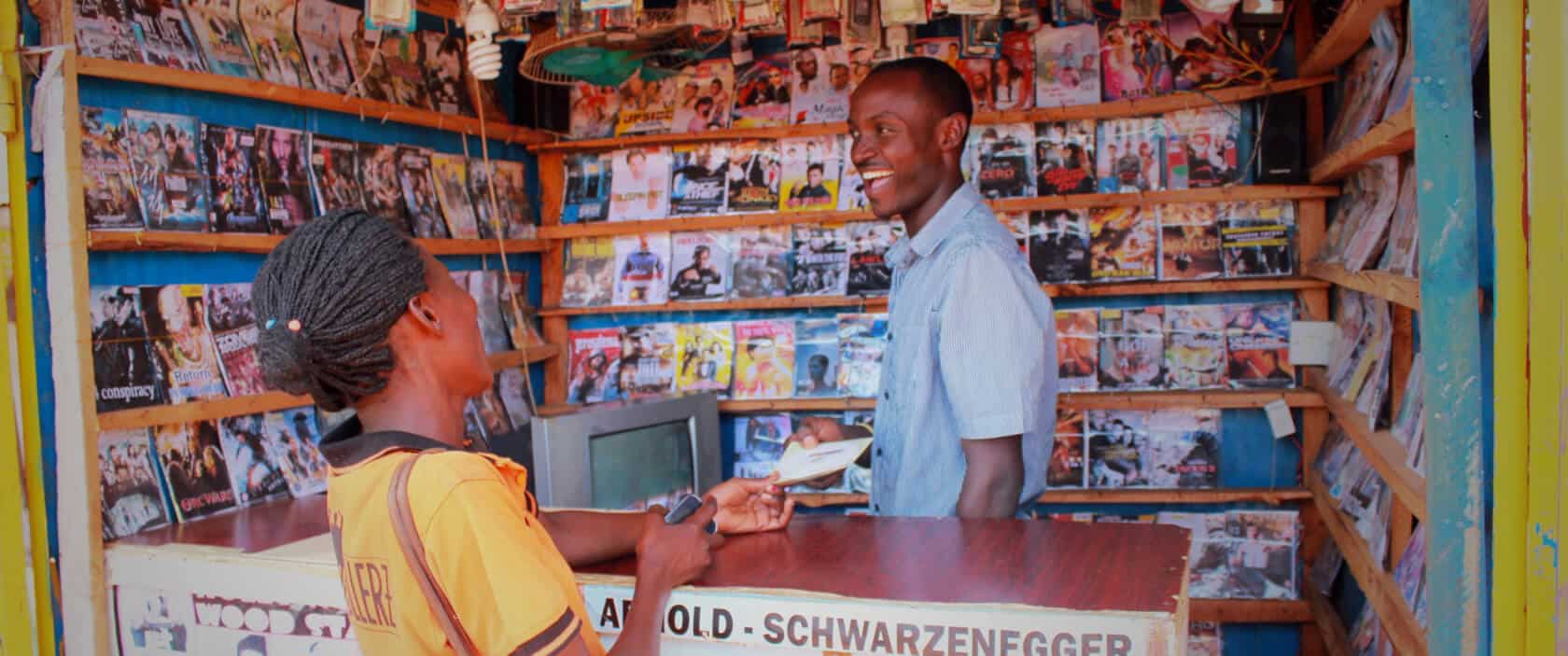Paul Falzone is at the forefront of Entertainment-Education with his organisation, Peripheral Vision International. We found out more bout his work in East Africa in this wide-reaching interview.
Paul Falzone founded Peripheral Vision International (PVI), a non-profit researching, creating and distributing innovative Entertainment-Education (EE) media in East Africa and beyond.
I have chosen this as a brief introduction for him, but Falzone’s contribution to improve the world and make a difference only begins here.
Just recently, he has co-edited the book Entertainment-Education Behind the Scenes, which brings together most of the major scholars in the field.
With a background in social and behaviour change communication and EE, he has worked with dozens of partner organisations over the last two decades in creating edutainment television shows, web video, public service announcements, interactive audio stories and short and feature-length documentaries.
In this interview, he gives for Youth Time, Falzone shares the inspiration behind PVI and the book’s key takeaways as well.
He elaborates on his experience with how media works in Uganda, why it is crucial to listen and write about people’s stories, and also highlights the differences between adult-focused EE and youth media, which is concentrated more on the development of cognitive skills.
Read on for an entertainment and educational story at once, like no other.
Media in Uganda
PVI uses media, technology, and popular culture to catalyse social change in East Africa.
Working in a multidisciplinary team and together with partners, PVI designs and tests communication on health, livelihoods, and citizenship for hard-to–reach and marginalised populations.
Falzone recalls, back in 2010, he worked with activists in the field in Uganda who were trying to use the media to raise concerns around corruption and natural resource issues.
“What I discovered was that even though I thought I knew a lot about media from having been a professor and producer and whatnot, I knew absolutely nothing about the unique way that media worked in Uganda.”
This was so exciting for him.
“Not knowing anything was a wonderful adventure. From day one I just started walking into places and meeting people – musicians and local filmmakers and the folks selling bootleg films and the ones running these little wooden cinemas called bibanda,” he adds.
Everyone was so welcoming and introduced him to other people.
Amidst this excitement for a new call, one thing was obvious – nobody from the world of International Development had ever approached them [the local communities] before.
“The International Development organisations were having workshops in fancy hotels for people in suits. We saw right away that there was talent and insight and opportunity outside those venues.”
Hence, PVI was founded as an organisation that could be nimble and inventive and collaborative and work with creative folks to rethink how media could help to make a better world.
Giving The Voice To People
Surely, one of his greatest impacts in the world of entertainment and education is his academic contribution to the field.
Speaking about the above mentioned book, he explains that all across the world, there are major entertainment-education projects that are reaching literally hundreds of millions of people.
“I am talking about radio and television programs, films, games, online and social media campaigns, comics and more.”
But there had not been a major collection on the topic since 2004.
“Can you imagine?” he curiously asks us.
“That was before the world had access to Facebook or YouTube. It was before the invention of the iPhone,” Falzone further illustrates.
“We were living in a different world in terms of technology, but the literature had not caught up. Not even close.
“Rather than trying to write that book ourselves, my collaborator Dr. Lauren Frank and I realized it was the people doing the work that should tell the story.”
So, they reached out to one or two of the people who they most respected in the field – folks that they did not imagine would want to take part in their little book project.
But everyone said “Yes – We need a book about this!”
“This is how we brought together so many of the major scholars, producers and practitioners in this field. And the big takeaway is this: stories can be powerful, but you must involve the people who the stories are for and about.”
He believes one should always listen to their audience.
“You need to platform their [audience’s] voices and their issues. You need to take them seriously. When you have authentic voices, you can create authentic stories that help change lives.”
Notably, he goes on, technology is important, but still it is just a tool to tell stories.
Reaching Three Continents
While reading the Last Mile Media: A How-To Guide chapter, what caught my eye was that in recent years Falzone has used those principles of Last Mile Media to expand to other countries, producing and distributing EE media that has reached hundreds of millions of impressions across dozens of countries- in this form, expanding from his fieldwork in Uganda.
Does this expansion illustrate how great local communities have embraced his work, and how he sees this?
“Over the course of about two years, we went from an NGO working almost entirely in Uganda to one where we have various projects running and TV shows playing in dozens of countries on three continents. And the reason we could do that was largely by shifting how we thought about partnership.”
He insists- it is the organisations in the field that know their topic the best, that have the passion and the connection and the expertise in their issue, whether it is public health or human rights or livelihoods or some other issue.
“But they are not thinking like advertisers,” he adds.
“So their challenge is often to reach the most remote members of their community. I think about PVI’s role almost like a company that makes amplifiers. Our role is to make that connection—to amplify their voices to the people they are trying to reach.”
PVI listens up front, to learn about people’s goals and their sticking points, and only at that point PVI thinks about the best co-design to help them achieve their goal.
“So we have learned to be a lot humbler about voice and representation, and that has really been at the heart of this scale.”
Exploring the Characteristics of Youth Media
If you are a regular Youth Time reader, you already know that our platform never turns a blind eye to youth’s voices in every field or issue.
So, in this piece, we also spoke to Paul Falzone about a chapter of this book, which is dedicated to youth and EE.
It highlights the differences between adult-focused EE and youth media, which is focused more on the development of cognitive skills.
He briefs us on the youth media’s role in EE and its power to affect social and behavioural change.
“I think we are also just coming to understand the critical role that early childhood development plays in a host of broader social issues.
“Organisations like Ubongo and Sesame Workshop understand this and actively use media to help make lifelong pathways in the brain that will generalise out to a host of other issues,” he says.
One thing that is true about the media is that it is incredibly difficult to change someone’s mind once they already made it up, he believes.
“So ‘norms change’ via the media is really an uphill battle. The best you can do is to reorder or reframe an existing norm.”
For instance, he further shares, the marriage equality movement is about getting voters to prioritise norms that they already held about family, love and equality and relate that to the marriage issue.
He emphasises the opportunity for working with young people is that their norms are still taking shape.
“Youth are much savvier and enthusiastic consumers of media than older audience members. They are looking to the media to make sense of the world and their place within it.”
He genuinely believes youth understand and appreciate the power of communication and adapt to it much more quickly than an older audience.
“So when you are working someplace like Sub-Saharan Africa, which has the largest youth population in the world-it makes sense that this is the audience that you would want to work with.”
“This is the power of focusing on youth – it is easier and more powerful.” he concludes.
About Falzone
Prior to founding PVI, Paul taught media studies at the undergraduate and graduate level and also designed a college major in Media Advocacy.
His media-related writing has appeared in a range of peer-reviewed journals and academic books.
Falzone holds an MS in Conflict Resolution from Nova South-eastern University and an MA and PhD in Communication from the Annenberg School for Communication at the University of Pennsylvania, where his research centred on video and advocacy.
PVI Launched N*GEN, A Science TV Show for Kids in Sub-Saharan Africa. Find out more:
The first Pan-African Fun Science Show for Kids: Learning with N*Gen
Support us!
All your donations will be used to pay the magazine’s journalists and to support the ongoing costs of maintaining the site.
Share this post
Interested in co-operating with us?
We are open to co-operation from writers and businesses alike. You can reach us on our email at cooperations@youthtimemag.com/magazine@youthtimemag.com and we will get back to you as quick as we can.










